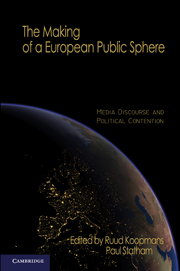Book contents
- Frontmatter
- Contents
- Tables
- Figures
- Contributors
- Acknowledgments
- Introduction
- Part I A European Public Sphere
- 1 The European Union and the Public Sphere
- 2 Theoretical Framework, Research Design, and Methods
- Part II European Public Debates
- Part III Mass Media
- Part IV Political Actors
- Part V Conclusion
- References
- Index
1 - The European Union and the Public Sphere
Conceptual Issues, Political Tensions, Moral Concerns, and Empirical Questions
Published online by Cambridge University Press: 05 June 2012
- Frontmatter
- Contents
- Tables
- Figures
- Contributors
- Acknowledgments
- Introduction
- Part I A European Public Sphere
- 1 The European Union and the Public Sphere
- 2 Theoretical Framework, Research Design, and Methods
- Part II European Public Debates
- Part III Mass Media
- Part IV Political Actors
- Part V Conclusion
- References
- Index
Summary
Truly political assembly only prospers under the great protectorate of public spirit, as the living prospers only under the protectorate of a clear air.
Karl Marx, Rheinische Zeitung, May 1842A public sphere deficit of Europe?
In the aftermath of the Treaty of Nice (agreed to by the European Council in December 2000), the leaders of the European Union (EU) decided to promote a debate on the future of European integration. They were worried by a growing alienation among local elites and masses within the member states (Ludlow 2002). They created a public meeting of appointed representatives of national governments, national parliaments, the European Commission, and the European Parliament – next to representatives of candidate countries without a decision-making role. Their Convention on the Future of Europe started in Brussels in February 2002 and ended in June 2003. It conducted broad discussions about basic issues, such as European identity, supranational competence, and the power balance between large and small countries. It produced a draft constitution that provided the framework for a new Treaty of Rome, signed in October 2004 by all members of the European Council (Dinan 2005; Duff 2005; Norman 2003, pp. 173–182).
- Type
- Chapter
- Information
- The Making of a European Public SphereMedia Discourse and Political Contention, pp. 13 - 33Publisher: Cambridge University PressPrint publication year: 2010
- 19
- Cited by

